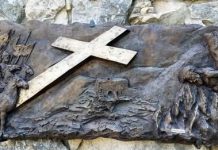Forgotten, but not gone: Fatah al-Islam still a factor in Lebanon
Justin Salhani/The Daily Star/Dec. 06, 2014
BEIRUT: For two years, Fatah al-Islam sent shockwaves throughout Lebanon with a spate of terrorist attacks, culminating in the battle of Nahr al-Bared. More than 400 people died during the clashes in the Palestinian refugee camp situated in north Lebanon, but Fatah al-Islam carried on operations for another year before largely disappearing from the public eye.
The battle of Nahr al-Bared in 2007 led to the death or arrest of many Fatah al-Islam militants. Those who evaded capture or later escaped from Roumieh Prison are believed by analysts to have merged with Islamist groups operating in Syria, on the Lebanese border, or inside Lebanon itself.
Fatah al-Islam was formed in 2006 by Shaker Al-Abssi, a Palestinian born in Ariha (Jericho) in 1955. After being released from a Syrian prison, Abssi traveled to Iraq to fight the U.S. invasion in 2003. There, he made connections with senior figures in Al-Qaeda, including Abu Musab al-Zarqawi.
In fact, Fatah al-Islam shares and supports the Al-Qaeda ideology – the only difference being the group’s view on takfiris and Shiites, whom Fatah al-Islam does not consider to be apostates.
Abssi carried this ideology with him to a village in the West Bekaa, where in 2005 he set up at a base for the Palestinian faction Fatah al-Intifada. Accompanying him were a number of men who had fought with him in Iraq. Attention from Syrian intelligence agencies, however, soon forced him to flee to refugee camps in north Lebanon.
Abssi based his unit in the Beddawi refugee camp near Tripoli, but split from Fatah al-Intifada when a Palestinian security committee from the camp turned over two of his men to Lebanese security forces. He took his loyalists and formed a new unit, Fatah al-Islam, operating out of the Nahr al-Bared refugee camp, also near Tripoli.
Fatah al-Islam quickly became the most prominent jihadi group in the country, building a reputation for itself by plotting ambitious terror attacks both in Lebanon and abroad, including a failed train bombing in Germany.
On May 19, 2007, Fatah al-Islam militants seized Lebanese Army vehicles stationed outside the Nahr al-Bared camp and a battle ensued that lasted nearly four months. It wasn’t until early September that the Lebanese Army retook control of the camp.
More than 400 people were killed. There were casualties from the army, militants and civilians.
The group was also loosely linked to the December 2007 assassination of prominent Lebanese Army figure Francois al-Hajj and a 2008 bombing in Damascus.
The last attack the group claimed was an explosion near Abdeh in north Lebanon that took place in late May in 2008.
Since then, Fatah al-Islam has largely faded from the public eye. But that doesn’t mean the members have stopped operating. In 2008, the group moved its base to the Sidon-based Palestinian refugee camp of Ain al-Hilweh.
Lebanese intelligence agencies continue to monitor members, making it difficult for them to operate in Lebanon. But many militants that were not killed or arrested and sent to Roumieh following Nahr al-Bared have dispersed and joined various jihadi groups, both in Lebanon and Syria, analysts told The Daily Star.
“Lebanese military successes in capturing group members have weakened the organization and have marginalized Al-Qaeda’s effort to use Fatah al-Islam as a conduit in Lebanon and Syria,” read a report released by California’s Stanford University and updated in 2014.
Abssi has been reported assassinated on multiple occasions, but analysts believe he may still be alive in either Lebanon or Syria.
When the uprising in Syria began in 2011, many of the remaining Fatah al-Islam members crossed the border and joined groups in the Free Syrian Army. As more extreme groups began to form, the Islamist-leaning among them broke away and joined those groups instead, said Dr. Haytham Mouzahem, director of the Beirut Center for Middle East Studies.
“Many left to Syria and joined Nusra or ISIS,” confirmed Dr. Ahmad Moussalli, a professor of political studies at the American University of Beirut and an expert on Islamist movements.
On multiple occasions, connections between Fatah al-Islam and jihadi groups in Syria have become apparent. In 2012, two Fatah al-Islam militants that had fought in Nahr al-Bared were killed while fighting in Syria. One of them had recently escaped from Roumieh.
On Dec. 18, 2013, the U.S. State Department designated one Usamah Amin al-Shihabi a terrorist, calling him “an associate of Fatah al-Islam” who “at times has played a key leadership role” in the group, but the brief also stated that Shihabi had “recently been appointed the head of Syria-based al-Nusra Front’s Palestinian wing in Lebanon.”
The latest connection emerged earlier this year when a local from Ras Baalbek was kidnapped by an ISIS cell operating on the Lebanese-Syrian border. According to locals from Ras Baalbek, the cell’s leader, Abu Hassan al-Filistini, was a former member of Fatah al-Islam who fought in Nahr al-Bared.
“A lot [of Fatah al-Islam members] are back in different areas in the north, Arsal, and other places,” said Moussalli, who speculated that the recent ambush outside Ras Baalbek could be connected to such people.
“They have a lot of problems with the Army and now they might be taking revenge as part of a larger organization,” he said.
Other analysts say that Fatah al-Islam members have taken part in other battles inside Lebanon in recent years.
“You may find them fighting in [the 2013 battle of] Abra with Sheikh Ahmad al-Assir or in Tripoli with Shadi Mawlawi and Osama Mansour,” said Mario Abou Zeid, a research analyst at the Carnegie Middle East Center.





















